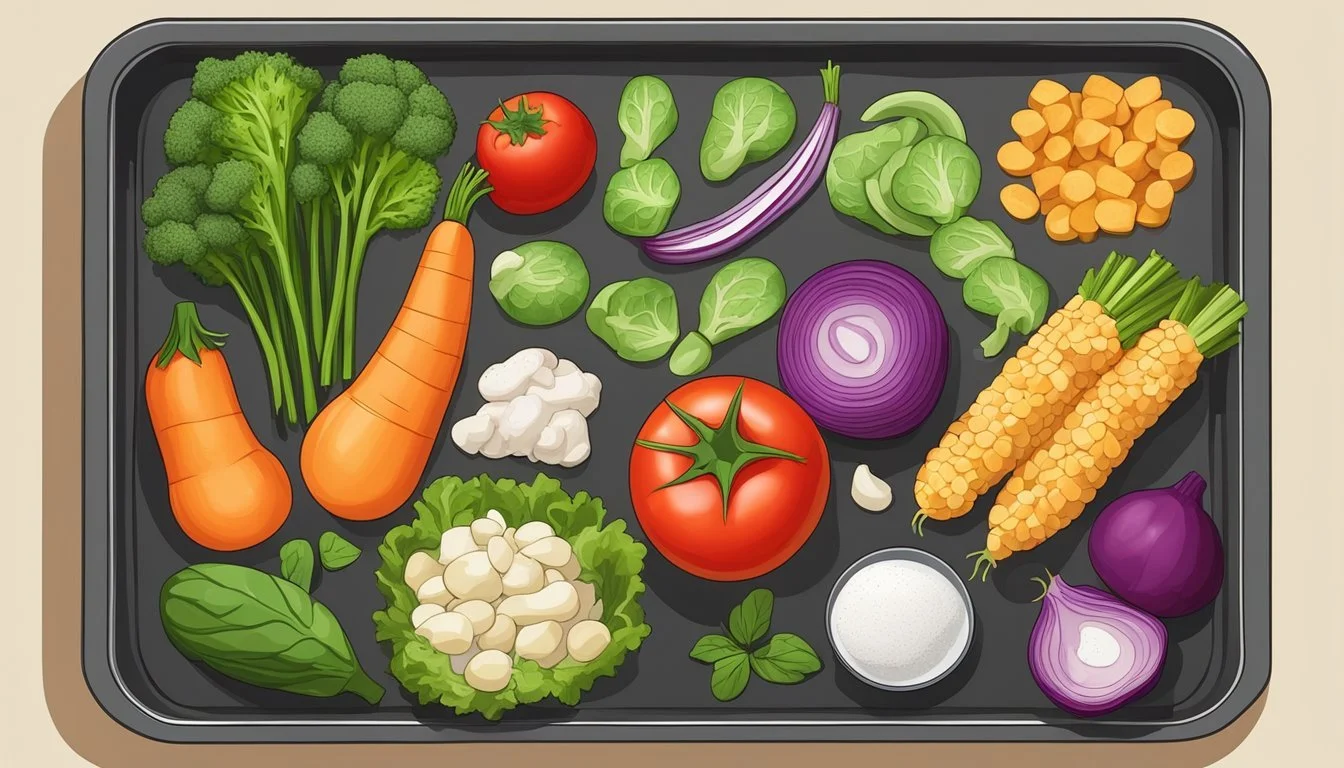The Faux-Fry Technique
Mastering Oven-Crisped Foods Without Deep Frying
The quest for healthier cooking methods has led to innovative techniques that allow food enthusiasts to enjoy their favorite crispy dishes without the excessive oil used in traditional frying. Among these methods, the faux-fry technique stands out by providing a way to achieve that desirable crunch and texture in the oven. This approach involves simulating the effects of frying through baking, offering a lighter alternative that doesn't sacrifice the golden exterior or the savory satisfaction associated with fried foods (What wine goes well with fried foods?).
Utilizing the oven for the faux-fry method is remarkably straightforward and convenient. It involves preparation steps such as breading with flour, dipping in egg wash, and then coating in breadcrumbs or other crisp-inducing ingredients to mimic the texture of fried food. While actual frying submerges the food in hot oil, faux frying typically requires a preheated oven, with the items placed on a baking sheet. This allows the heat to circulate around the food, crisping it up without the need for deep-frying.
This clever culinary strategy has been warmly embraced by health-conscious cooks and those who wish to reduce their intake of fats without compromising on taste. It is ideal for creating lighter versions of traditionally deep-fried favorites, utilizing the consistent and dry heat of an oven to deliver that much-desired crispy outcome. Through the faux-fry technique, chefs and home cooks alike are empowered to turn out scrumptious, healthier dishes that delight the palate and support a balanced diet.
Understanding the Faux-Fry Technique
The faux-fry technique offers a method of achieving the crispy texture of fried foods without the excess oil typically used in traditional deep-fat frying. This section will break down the methodology, compare it with other frying techniques, and illustrate its health benefits.
Definition and Origins
Faux-frying, a method dating back to when health-conscious consumers sought alternatives to deep-fat frying, involves baking foods at high temperatures in an oven to mimic the crunchiness of frying. In the process, a coating is often applied to the food to enhance the crispy texture. The origin of faux-frying aligns with the rise of home-based cooking practices aimed at healthier dietary options.
Comparing Faux-Fry to Deep Frying and Air Frying
Method: Submerging food in hot oil
Texture: Crispy exterior with a richer mouthfeel
Calories/Fat: High due to oil absorption
Faux Frying
Method: Baking in an oven with minimal oil
Texture: Crispy outer layer with less grease
Calories/Fat: Reduced in comparison to deep frying
Air Frying
Method: Cooking with circulating hot air
Texture: Similar to deep frying without submersion in oil
Calories/Fat: Lower than deep frying, comparable to faux frying
The comparison shows that both faux frying and air frying aim to provide a healthier alternative to deep frying by reducing fat and calories.
Benefits of Faux-Frying
Health Benefits: The faux-fry technique significantly lowers calorie and fat intake, which contributes positively to one's diet and overall health without sacrificing the desired crispy texture.
Diet-Friendly: It offers a cooking method that aligns with various dietary restrictions, promoting a balance between health and taste.
By understanding the faux-fry technique and its applications, individuals can make more informed choices about their cooking methods and diet.
Preparation for Faux Frying
Achieving a crispy outer layer on foods without deep frying requires a methodical approach to ingredient selection and batter preparation. Here's how one can ensure that faux-frying in the oven leads to deliciously crunchy results.
Choosing the Right Ingredients
The base of any faux-fried dish begins with selecting the right protein and breading components. When it comes to proteins, lean cuts work best; skinless chicken or white fish (What wine goes well with white fish?) are ideal candidates due to their mild flavors and firm textures. For the breading, a combination of flour, cornstarch, and breadcrumbs creates the necessary crispiness.
Breading Ingredients:
Flour
Cornstarch
Breadcrumbs
Creating the Faux-Fry Batter
The batter for faux frying acts as a crucial layer that helps the breading stick to the protein. One can start by whisking an egg with a small amount of milk to create an egg wash. The addition of cornstarch to the flour can improve the final crispness due to its drying properties.
Batter Mixture:
1 Egg
1/4 cup Milk
1 cup Flour
2 tablespoons Cornstarch
Seasoning Your Food
Seasonings not only add flavor but can also contribute to the texture of the faux-fried coating. Basics like salt and pepper are essential, but incorporating spices such as paprika and ground ginger, along with herbs like parsley, can elevate the taste profile. Make sure that seasonings are evenly dispersed throughout the breading and batter mixtures.
Suggested Seasonings:
Salt
Black Pepper
Paprika
Ground Ginger
Dried Parsley
By following these steps, one will have set the foundation for a successful faux-fry cooking experience.
Faux Frying Techniques
Faux frying techniques allow cooks to achieve a crispy, golden brown crust typically associated with deep frying, but with less oil and often in a healthier fashion. These methods involve an oven or skillet to simulate the effects of traditional frying.
The Oven Faux-Frying Process
The oven faux-frying process utilizes dry heat to create a crispy texture on the outside of the food. To start, the following preparation is essential:
Coat the Food: Begin by dredging the food in flour seasoned with spices or herbs to enhance flavor. Then, dip into a batter or beaten egg mixture, which will act as the glue for the breadcrumbs.
Breadcrumb Layer: After the batter, coat the food item in breadcrumbs, which can be plain or seasoned. For an even more crunchy finish, panko breadcrumbs are an excellent choice.
Baking Setup: Place the coated food on a wire rack over a baking sheet to allow heat to circulate evenly.
Temperature: Preheat the oven to a high temperature, often between 400°F to 450°F (200°C to 230°C), to ensure that foods crisp up well.
Cooking Time: Cooking times will vary depending on the food's size and thickness but generally should be until a golden brown crust is formed.
Skillet Faux Frying
Skillet faux frying is a stovetop alternative that makes use of a heavy skillet and minimal oil or butter to replicate a fried crust.
Preparation:
Ensure the skillet is non-stick or well-seasoned cast iron for best results.
Heat the skillet with a small amount of oil or butter to create a non-stick surface.
Cooking Process:
Medium-High Heat: Cook food on medium-high heat to form a crust quickly without burning.
Attention and Care: Watch the food closely, flipping it occasionally to brown all sides evenly.
Indicators of Doneness:
The food should release easily from the skillet once the crust becomes golden brown.
Touch and visual cues indicate crispiness and adequate cooking.
Using these methods, cooks create a healthier version of "fried" foods while still achieving the desirable texture and color.
Coating and Breading Variations
In the faux-fry technique, achieving a crispy and appealing texture in the oven relies heavily on the choice of coating. The variations range from traditional mixtures to gluten-free and alternative options, each providing unique flavors and textures to the dish.
Traditional Breading Mixtures
Traditional breading for achieving a crispy oven-baked finish typically involves a three-part process. Start with a dusting of flour to help everything stick, then dip the item in beaten eggs, and finally coat it in breadcrumbs. For added flavor, one can mix in grated parmesan and chopped parsley into the breadcrumb mixture.
Cornstarch: It can be used as a replacement for flour for a lighter coating and is particularly effective for seafood and chicken.
Corn Meal: Provides a coarser texture compared to traditional breadcrumbs and is often used for a southern twist on breading.
Breadcrumbs: Plain breadcrumbs are the most commonly used for this method, but for those who prefer a more robust flavor, seasoned or panko breadcrumbs are a flavorful alternative.
Gluten-Free and Alternative Options
For those requiring gluten-free options or simply seeking a different taste and texture, there are numerous alternatives.
Cornstarch: A gluten-free alternative to flour, cornstarch helps in creating a light, crispy coating that browns well in the oven.
Corn Meal: A naturally gluten-free option that gives a distinct crunch and flavor, suitable for both sweet and savory dishes.
Parmesan: For a low-carb breading, finely grated parmesan cheese mixed with herbs can provide a flavorful crispy crust.
By understanding these breading and coating variations, one can achieve a range of textures and flavors for oven-baked dishes that are just as enticing as their deep-fried counterparts.
Faux-Fry Cooking Recommendations
When cooking with the faux-fry technique, it is crucial to manage both the oven temperature for optimal crust formation and to use methods that preserve the meat's tenderness.
Optimizing Oven Temperature
To achieve a crispy crust akin to traditional frying, the oven temperature plays a pivotal role. For chicken, an oven preheated to 425 degrees Fahrenheit is generally effective in achieving a golden, crispy exterior while ensuring the meat is cooked thoroughly. On the other hand, white fish, being more delicate, often fares better at a slightly lower temperature, such as 375 degrees Fahrenheit, to avoid overcooking.
Maintaining Food's Tenderness
While crusty on the outside, the goal is to keep chicken or white fish tender on the inside. Marinating proteins in ingredients like lemon zest and milk can infuse chicken with flavor and moisture. For white fish, patting the fillets dry before seasoning with salt and pepper is crucial before proceeding with the flour, egg, and breadcrumb stations. These steps ensure the inside stays moist throughout the baking process, promoting a balance between a crispy exterior and a tender interior, all while reducing calories compared to traditional frying methods.
Nutrition and Dietary Considerations
When comparing traditional frying methods to the faux-fry technique, one must consider the impact on caloric intake and fat content. This section evaluates the nutritional differences and how faux-fried foods can fit into a balanced diet.
Calorie Comparison with Fried Foods
Traditional frying involves submerging food in hot oil, which leads to a high fat and calorie content. For example, deep frying a chicken drumstick can significantly increase its calorie and fat content compared to baking. Faux frying, which mimics the texture of deep-fried foods using the oven, results in a lower calorie count because it often requires less oil. A breadcrumb coating, when browned in the oven, provides a crispy texture without the need for excess oil, cutting down on calories.
Incorporating Faux Fried Foods into a Healthy Diet
Dieticians recognize the need to balance enjoyment with nutrition. Faux-fried foods, when made with whole food ingredients like whole-wheat flour or almond meal, offer more fiber and nutrients than their deep-fried counterparts. Incorporating these foods in moderation allows individuals to enjoy the taste and tenderness of fried foods while maintaining a healthy diet. It's important to accompany these dishes with a colorful array of vegetables and lean proteins to ensure a balanced intake of carbohydrates, fats, and proteins.
Serving and Presentation Tips
When serving faux-fried foods, the key to impressing diners lies in the selection of side dishes that complement the main course and the presentation that enhances the visual appeal. A carefully arranged plate not only showcases the dish but also elevates the dining experience.
Accompaniments and Side Dishes
Faux-fried dishes, known for their crispy texture and golden-brown color, pair well with lighter sides to balance the meal. A flavorful rice pilaf laden with sautéed onions and garnished with parsley can provide a tender contrast to the crispiness of the faux-fried main. For a refreshing touch, consider a simple salad dressed in a light vinaigrette.
Suggested Side Dishes:
Rice pilaf with onions and parsley
Green salad with a simple dressing
Steamed vegetables lightly tossed in olive oil
Plating for Visual Appeal
Presentation is crucial, as eaters feast with their eyes first. Arrange the faux-fried item to be the star of the plate, achieving a golden brown hue as the centerpiece. Utilize parsley to add a pop of color and freshness. Consider the smear technique using sauces to create a visually appealing design, guiding the eye along the plate.
Plating Techniques:
Anchor the faux-fried item in the center or to one side of the plate.
Use a bright garnish, like chopped parsley, to provide contrast.
Create dynamic sauce patterns such as dots or smears for artistic flair.
Engaging with Your Audience
The faux-fry technique allows health-conscious individuals to enjoy crispy foods without the excess oil associated with traditional deep frying. This cooking method is gaining popularity among those who prefer a diet-friendly alternative. Sharing and interacting with your audience on social platforms like Facebook can further expand the reach and appreciation of faux-fry cooking methods.
Sharing Faux-Fry Recipes on Social Media
Chefs and home cooks often turn to Facebook to showcase their culinary creations. By sharing faux-fry recipes, one can inspire others to try out this healthier cooking method. Here are some tips for effective recipe sharing:
Use High-Quality Images: A crisp, clear photo of the final dish can make a huge difference in catching people's attention.
Clear Instructions: Provide step-by-step instructions to ensure others can replicate the dish successfully.
Hashtags and Tags: Utilize relevant hashtags like #fauxfry and tag pages or groups focused on healthy cooking to increase visibility.
Encouraging Feedback and Interaction
Engagement is crucial on platforms such as Facebook. Ask for feedback and encourage responses to foster a community of faux-fry enthusiasts. Here are strategies to promote interaction:
Ask Questions: Post queries such as, "What's your favorite food to faux-fry?" to prompt comments and discussions.
Respond Promptly: When someone leaves a comment or question, a quick and thoughtful response can build rapport.
Create Polls and Contests: Involve the audience by running polls about faux-fry techniques or contests for the best faux-fried dish.
Conclusion
The faux-fry technique has established itself as a reliable method for producing crispy foods without the need for traditional deep-frying. This method is not only healthier, but also accessible, requiring nothing more than an oven and a few key tools and ingredients.
To summarize, the technique involves:
A high cooking temperature to ensure food gets that desirable golden-brown exterior.
Circulating air, which is crucial for even cooking and crispiness.
Light coatings of oil, which can be applied with a spray to mimic the effect of deep-frying.
The results of faux-frying are remarkably similar to deep-frying, offering a crunchy texture and rich flavor without an excessive amount of oil. Food items retain more nutrients and it allows for a diverse meal preparation, replicating an array of traditional fried foods.
For diners seeking healthier options without sacrificing taste, the faux-fry technique is an excellent choice. It demonstrates that with the right approach, one can enjoy the essence of fried foods in a more nutritious form. The applications in the food industry are promising and it's becoming a popular method in home kitchens as well.
This technique aligns with the growing trends of health-conscious eating and innovative cooking practices. As a testament to its efficacy, one finds a growing number of recipes and appliances dedicated to perfecting non-fried crispy foods.
Nutritionists and chefs alike recognize the benefits of the faux-fry method, and it is likely to remain a favored technique for years to come.








